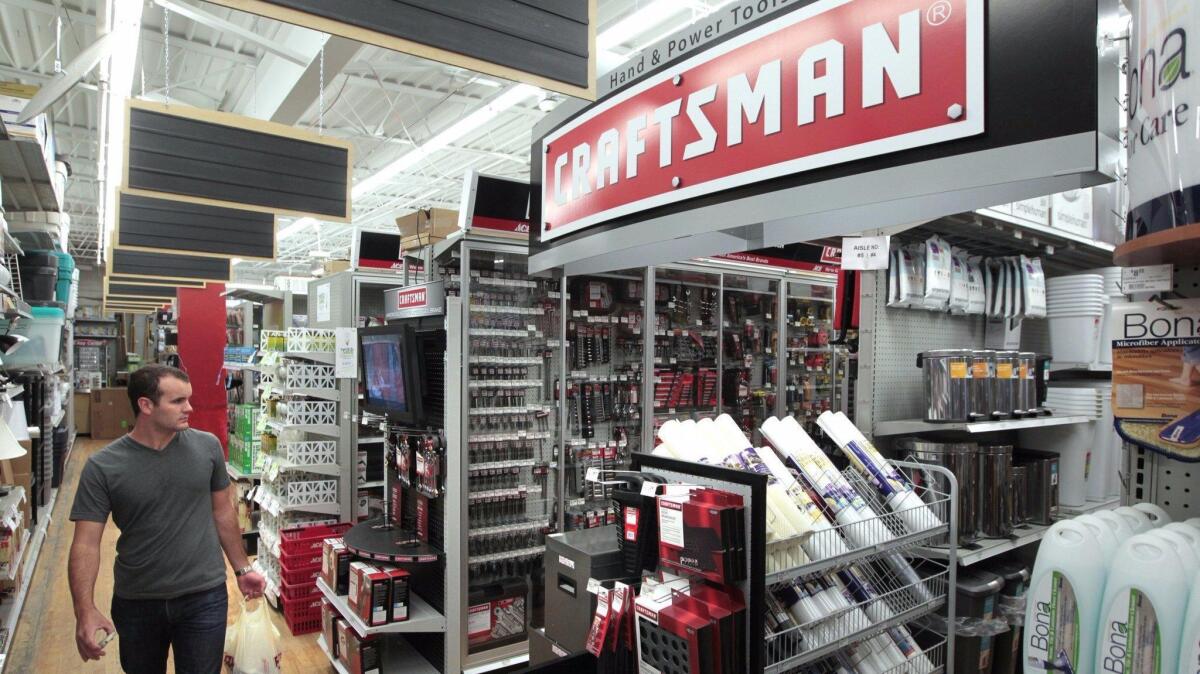Sears is selling its Craftsman tool brand to Stanley Black & Decker

- Share via
Sears Holdings Corp. will sell its well-known Craftsman tool brand to Stanley Black & Decker, the latest in a recent flurry of moves the retailer is making to generate cash after at least five money-losing years.
The agreement announced Thursday calls for Stanley to pay $525 million when the deal closes — expected later this year — and $250 million more after three years, the companies said. Stanley of New Britain, Conn., will pay Sears a percentage of its sales of Craftsman products for 15 years, and during that time Sears will be able to continue selling Craftsman products royalty-free.
Sears, based in Hoffman Estates, Ill., estimated the deal’s value could top $1 billion.
Separately on Thursday, Sears said it’s trying to raise an additional $1 billion by selling off real estate. On Wednesday, affiliates of the hedge fund managed by Sears’ chairman, chief executive and biggest investor, Edward Lampert, lent Sears as much as $500 million to fund operations while it negotiates those sales.
Sears announced in May that it was looking for ways to wring more cash from some of its best-known brands — Craftsman, Kenmore and DieHard.
Craftsman still accounted for the largest share of the hand tools and accessories market by dollar share as of September, with about 26.6%, and accounts for about 8.3% of portable power tool sales, according to Stevenson TraQline, a market research firm. But its share in both categories declined nearly 6% over the last four years, shrinking alongside Sears’ sales.
Currently, about 90% of Craftsman products are sold through Sears, Kmart and Sears Hometown stores, Stanley President and CEO James Loree said on a conference call Thursday. Much of the 10% sold outside Sears-related channels is sold through Ace Hardware stores.
Craftsman’s appeal might be slightly stronger with older customers who remember it from decades ago, when the Sears catalog’s role was similar to that of e-commerce today, Loree said. But he estimated the brand could add about $100 million in revenue growth per year for the next 10 years, in part by making Craftsman products more widely available.
“The world has changed, but Craftsman is still an incredibly strong brand,” he said.
Stanley is working on plans to begin expanding Craftsman’s distribution but currently sells Stanley and Black & Decker brands to some of the biggest home and hardware retailers, including Home Depot, Lowe’s and Amazon.
The availability of Craftsman products outside Sears could give shoppers even less reason to venture into its department stores. But those sales will generate cash for Sears, said Craig Johnson, president of consulting and research firm Customer Growth Partners.
“If the concept is to monetize some of Sears’ assets, it’s hard to think of a better partner to make that happen than a company like [Stanley],” he said.
Sears has sold off multiple assets in an effort to turn itself from a traditional department store chain with a big bricks-and-mortar footprint into a nimbler retailer focused on membership and online sales.
The company previously spun off its Sears Hometown & Outlet and Lands’ End businesses. In 2015, it sold 235 stores to a real estate investment trust spinoff, Seritage Growth Properties, and raised $2.72 billion.
On Wednesday, Sears said it would close 150 unprofitable stores.
Last week, affiliates of Lampert’s hedge fund, ESL Investments, gave the retailer a $200-million letter of credit that could be expanded to $500 million.
Lampert and his hedge fund’s loans to the retailer add up to more than $1 billion since September 2014.
“We are taking strong, decisive actions today to stabilize the company and improve our financial flexibility in what remains a challenging retail environment,” Lampert said in a news release. “We are confident that concentrating on these key initiatives will lay the foundation for growth over the long term.”
Sears did not make Lampert available for an interview.
Sears’ sales have been shrinking for years but could be facing extra pressure after a holiday season that is shaping up to be a dismal one for some traditional department stores.
During November and December, sales at Sears and Kmart stores open at least a year declined at least 12% from a year earlier, Sears said. On Wednesday, Macy’s and Kohl’s each reported a 2.1% drop in sales during those two months. Macy’s said it had expected stronger sales and announced plans to close 68 stores by spring.
“My sense is [Sears has] been having a tough go in general for the last couple years, but this year has been particularly bad for malls and mall-based anchors,” Johnson said.
The deal with Stanley — on top of other recent cash infusions — is “like a life preserver that couldn’t have come at a better time,” he said.
ALSO
Amazon’s Alexa may be listening, but will she tell on you?
Aerospace firms compete harder with Silicon Valley for young engineers
Snapchat showed investors false user statistics, ex-employee alleges in lawsuit
More to Read
Inside the business of entertainment
The Wide Shot brings you news, analysis and insights on everything from streaming wars to production — and what it all means for the future.
You may occasionally receive promotional content from the Los Angeles Times.










